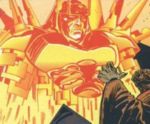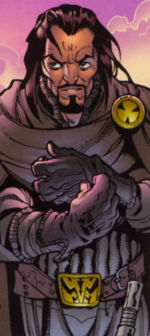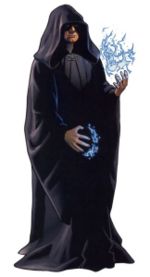|
|
History of the Sith
From TheHolo.Net Forums Wiki
The History of the Sith is a long and complex story, spanning tens of thousands of years. The Sith were a dark side organization bent on galactic conquest. The Sith Order existed in many forms and structures throughout history.
|
The Ancient Sith
|
| The history of the Sith Order begins with the species of that name, a primitive but Force-sensitive group of humanoids, possibly descended from some of the earliest groups of Human colonists that arrived on Korriban many hundreds of thousands of years before the Galactic Empire .
The culture of the Sith dated back to 130,000 BBY and remained virtually free of outside influence until 7,000 BBY, which allowed its people to develop a unique culture.
A warlord named Adas managed to briefly unite the inhabitans of Korriban, becoming King, or Sith'ari, in the language of his people. During Adas's centuries-long reign, an alien race, the Rakata, attempted to conquer Korriban and enslave its people, but Adas fought them off, emerging triumphant—but at the cost of his own life. The technology for Sith holocrons originated from this first contact between the Sith and the Rakata, and King Adas crafted his own holocron before his death.
Sometime during the later history of the Sith people, the story of Adas would merge with other traditions, creating the legend of the Sith'ari, the prophesied savior of the Sith Order. According to this prophecy, the Sith'ari was a perfect being who would rise to power and bring balance to the Force. Allegedly, the Sith'ari would rise up and destroy the Sith, but in the process would return to lead the Sith and make them stronger than ever before. Many have been called Sith'ari, from Darth Revan to Darth Sidious; but none of these truly fulfulled the prophecy, with the exception of Darth Bane who arguably restructured the Sith Order into an incarnation that would ultimately lead to the temporary destruction of the Jedi.
After Adas's death, the unity of the Sith splintered, and though many would later claim his title, none would truly rule over the entire world again. Eventually, civil war has so devastated Korriban, that the focus of Sith culture moved to Ziost.
It would be here that the next era of Sith history would begin.
|
|
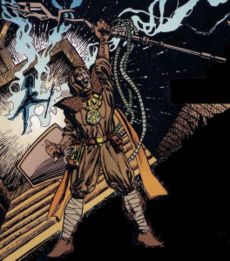 Xendor, the first Dark Jedi and the Father of the Sith Order.
|
The Great Schism
|
| The First Great Schism, which occurred around 24,500 BBY was the name given to the original break between dark side and light side Force traditions. Xendor, who some call the first Dark Jedi, began to argue that the Jedi's focus on unemotional meditation was concealing the "true power" of the Force from them. Xendor's students, known as the Legions of Lettow or the Minions of Xendor went to war with the Jedi, but were defeated.
Many more schisms followed in the ensuing centuries, but none would have the consequences of the Hundred-Year Darkness in 7,000 BBY, where the Dark Jedi, once again defeated, were banished from known space.
They arrived on Ziost, the home of the Sith people. The Dark Jedi impressed the Sith with displays of Force power, and became the rulers of the planet.
|
|
The First Sith Empire
|
| Over time, the Dark Jedi intermarried with the Sith, and the two identities merged. The term ‘Sith’ would later come to refer to the Dark Jedi who followed the codes of these ancient Jedi, although Dark Jedi individuals and organizations outside the Sith tradition continued to exist, such as that of the Nightsisters of Dathomir.
This merging of Dark Jedi and Sith led to the first use of the title Dark Lord of the Sith, originally awarded by a council of Sith Lords to their leader.
|
|
|
The Fall of the Sith Empire and the Freedon Nadd Uprising
|
| 5,000 BBY, the Republic rediscovered the Sith and the Great Hyperspace War began. Though it ended with Dark Lord of the Sith Naga Sadow in suspended animation on Yavin 4 and his great war fleets destroyed, the Sith Empire survived. It was believed to have collapsed shortly afterward due to internecine and attacks by the Republic, but it was later discovered that the Sith Empire had retreated into the Unknown Regions, where the Lords of the Sith waited patiently for over a millennium for the right moment to return.
Six centuries later, a Jedi Knight named Freedon Nadd felt the calling of the dark side and journeyed to Yavin 4, where he awakened Dark Lord Naga Sadow. Sadow trained the Knight in the ways of the Sith before being killed by him in classic Sith fashion. Freedon Nadd used his newfound powers to conquer the planet Onderon, estabilishing himself as monarch and spreading Sith darkness in the system. The royal family of Onderon is descended from him.
|
|
The Great Sith War
|
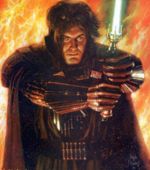 Fallen Jedi and Sith Lord Ulic Qel-Droma - "In my time, even as the Galactic Republic battles us to extinction, we now secure the future, when the Sith will take their revenge!"
- ―The spirit of Marka Ragnos speaking to Exar and Ulic
Four hundred years after Nadd's death, the Jedi Exar Kun sought out his tomb, a place strong in the dark side. He found Nadd's spirit, who corrupted Kun, but was eventually destroyed by his student. Exar Kun was pronounced the new Dark Lord of the Sith by the ghost of the ancient Dark Lord Marka Ragnos. As his first apprentice he took another fallen Jedi, Ulic Qel-Droma, and the Great Sith War began.
Although several more Jedi turned to the dark side and many more were killed, Exar Kun was finally defeated when Ulic realized the error of his ways and led Republic forces to Kun's base on Yavin 4. Using the drained life energies of his Massassi warriors, Kun shed his physical body and imprisoned his spirit within the walls of Yavin 4's Massassi temples. There, his ghost was driven half-mad by millennia of isolation.
Most of what remained of Kun's Sith Brotherhood by the end of the Great Sith War was hunted down by the Republic in a purge known as "the Cleansing of the Nine Houses."
|
|
The Jedi Civil War
|
- "The reason the Jedi Civil War was named such was because few in the galaxy can recognize the difference between the Sith and the Jedi. To them, they are both Jedi—with different philosophies."
- ―Mical
Less than four decades after the death of Exar Kun, the Jedi Knight Revan, hero of the Mandalorian Wars, discovered a deserted academy belonging to the old Sith Empire. He used the teachings there to form a new sect of Sith, taking his friend Malak as his apprentice, and declaring himself Dark Lord of the Sith. Further, the academy supposedly revealed to Revan that the silent Sith Empire still lurked in the Unknown Regions, and was likely the instigator of the Mandalorian Wars.
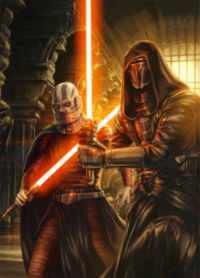 Darth Revan and Rarth Malak Revan's conflict proved even more devastating than Exar Kun's war, as more Jedi fell to the dark side, were killed in battle, or were murdered by Sith assassins than in the past two wars combined. Revan was the greatest military genius the Jedi had ever seen. It was through his cunning alone that the Mandalorian Wars were won, as the Republic soon discovered. In light of this new information, the Jedi Council ordered several Jedi Knights, including Bastila Shan, to board his flagship and capture the Dark Lord. Engaging several Jedi in a fierce lightsaber duel, Revan held the upper hand. However, a coup by Malak resulted in the Dark Lord's near-death—turning his cruiser's guns against Revan's flagship, Bastila's strike force was able to win, but at a heavy cost. Revan's mind was nearly destroyed by this encounter, but he was re-trained in the ways of the Jedi under a new identity implanted in his mind by the Jedi Council.
Taking up the mantle of Dark Lord, Malak redoubled his empire's offenses against the Republic, with none of the delicate subtlety of Revan’s plans—caring nothing about preserving his enemy's resources or sparing civilian populations...indeed, how much Malak knew of Revan's ultimate intentions is still in question.
Following a long and arduous quest for the five Star Maps that would lead him to the Sith's stronghold, the newly-reprogrammed Revan led a frontal assault on the Star Forge. He battled his way through the Forge's droid army and legions of Sith and Dark Jedi. After redeeming Malak's apprentice, Bastila Shan, he slew Malak himself in a final confrontation between the old friends, allowing the Republic to destroy the Star Forge and win the day.
Despite this great victory for the Republic, the galaxy soon grew even darker. A year after the battle, Revan departed into the Unknown Regions, leaving his friends behind. His motives for going alone to face the ancient Sith were unknown. Few Jedi remained after the Jedi Civil War, and those who did soon found their ranks thinning at an alarming rate. Everywhere Jedi congregated, they were murdered, struck down by an invisible enemy who, incredibly enough, was somehow attacking through the Force itself.
|
|
The Triumvirate
|
- "To be united by hatred is a... fragile alliance at best."
- ―Darth Traya
The former Jedi Master Kreia, in search of the reason for Revan's fall, stumbled across the same academy that Revan had used. There, she was corrupted, becoming Darth Traya. Together with her students, Darth Nihilus and Darth Sion, she began a shadow war against the surviving Jedi. Despite their incredible powers, they did not believe themselves strong enough to defeat their enemy in the same kind of open warfare employed by Malak and Revan. Even though Traya had trained them in the ways of the Sith, Nihilus and Sion soon grew tired of her views, and cast her out of the Dark Lord triumvirate. They continued their crusade against the Jedi alone.
 Darth Traya, Darth Nihilus and Darth Sion - the Triumvirate In the end, most, if not all, of the Dantooine Jedi Council were killed, but the Exile managed to turn the tide against the insidious "shadow Sith," discovering Kreia's true identity, and slaying her together with Nihilus and Sion... thereby ending their Jedi purge, and giving the Jedi Order a chance to rebuild over the next several centuries.
In modern history texts, the Great Sith War, the Cleansing of the Nine Houses, the Mandalorian Wars, and the Jedi Civil War are often grouped together under the collective appellation of "the Old Sith Wars."
At some point during these years, the Sith stole the secrets behind advanced power-gauntlet construction from the designers of Eriadu, and adapted them to create their own unique form of protection. Such items utilized almost uncomfortable bursts of repulsorlift energy to assist in movement, and are rarely—if ever—seen outside of Sith possession.
|
|
New Sith Wars
|
- "Either we win this war or the Sith will, and what then will change?"
- ―Lord Hoth
Slowly, over the next thousand years, the Jedi Order rebuilt itself back to its former strength.
Around 2,000 BBY yet another Jedi, chafing under the restrictions of the Jedi Council, fell to the dark side, took the name Darth Ruin, and formed a new Sith Order, with himself as the Dark Lord. Ruin began recruiting others to his cause. This spawned a new series of conflicts, called the New Sith Wars, which lasted for a millennium. By 1,466 BBY, the Sith had conquered all of known space outside the Colonies.
However, the Sith very nearly proved to be their own undoing. Hungry for power, they turned on each other, all but destroying their order. The survivors reformed under the leadership of Lord Kaan, calling themselves the Brotherhood of Darkness. To appease his disheartened minions, Kaan abandoned the millennia-old tradition of one ruling Dark Lord and granted the title to a good number of his followers, though very few of them were deserving of it.
The final conflict of the New Sith Wars - often referred to as the Great Sith War, just as Exar Kun's war had been - came to a head in the titanic Seventh Battle of Ruusan, in which the Jedi Hoth and the Army of Light clashed with Kaan and the Brotherhood of Darkness for the last time. In the end, a deranged Kaan activated a thought bomb, an ancient Sith technique that sapped the life forces of all those Force-sensitive in the vicinity. Both armies were all but destroyed, and only one Sith Lord survived: Darth Bane.
To guard against the Sith destroying themselves or losing sight of their "ideals" once again, Bane took only one apprentice, restarting the tradition of the one master, one apprentice and that of passing the name Darth to each of his successors. Perhaps in a nod to Kaan's earlier pronouncement, both master and apprentice in Bane's Sith Order held the title Dark Lord of the Sith, making them, nominally at least, equals. The new tenets of the sinister order would become cunning, stealth, subterfuge and most of all, a virtue borrowed from their worst enemy, patience.
|
|
The Revenge of the Sith
|
- "Once more the Sith shall rule the galaxy!"
- ―Darth Sidious to Anakin Skywalker, after ordering him to attack the Jedi Temple.
Bane's reformed Sith Order went into hiding, though they were soon discovered by the Jedi and hunted until they were believed to be destroyed. The Sith survived, but would not resurface for almost one thousand years, awaiting the birth of one who had the power, intellect, influence, and patience required to return them from hiding. That one was Darth Sidious, who triggered his master plan with the Battle of Naboo.
Though his apprentice, Darth Maul, was slain in that battle at the hands of Jedi Padawan Obi-Wan Kenobi, the day proved an unparalleled victory for the Sith; Darth Sidious, as Senator Palpatine of Naboo, was elected to the office of Supreme Chancellor of the Galactic Republic.
More than a decade passed, during which Palpatine manipulated the Senate into granting him more and more powers. His new apprentice, Darth Tyranus, formed the Confederacy of Independent Systems, which seceded from the Galactic Republic, thus beginning a long and bloody conflict known as the Clone Wars.
When the Clone Wars ended with Darth Tyranus' death, the Jedi ranks had been thinned considerably. At last, the moment had come for the Sith to reclaim their former glory. Supreme Chancellor Palpatine — Darth Sidious — crowned himself Galactic Emperor, and replaced the ancient Republic with a "New Order" — the Galactic Empire — a galaxy-spanning dark side theocracy disguised as a dictatorship the likes of which had not been seen for millennia.
Sidious eliminated the Jedi by revealing himself to them at the proper time. When they attempted to arrest him, he made it look like an assassination attempt, giving him a legal basis to outlaw them. He then turned their greatest, Anakin Skywalker, into his apprentice, Darth Vader.
The Great Jedi Purge began, led by Palpatine's Dark Jedi underlings (including groups known respectively as the Inquisitorius, the Emperor's Hands, and the Prophets of the Dark Side) and Darth Vader. The Purge ensured that what few Jedi remained became even fewer, until only a handful of the original ten thousand remained. It was a dark time for the galaxy..
Eventually, however, the Rebel Alliance arose to threaten the Empire. The Galactic Civil War drew many into its fold, perhaps the most notable of whom was Luke Skywalker, the son of Anakin Skywalker. Shortly after Skywalker destroyed the Empire's terrifying Death Star superweapon, the Emperor and Vader became aware of the young man's identity. Both Sith Lords hoped to corrupt Luke to the dark side, but each had a different plan for the future. Vader desired to kill the Emperor and rule the galaxy with his son, but Palpatine wished to replace Vader with the boy. Neither goal was successful, and it appeared that the Sith had finally come to an end, as originally prophesied by the Jedi. With the destruction of the second Death Star at the Battle of Endor, Darth Vader returned to the light side, slaying his master and being slain in return.
|
|
The Sith Survivors at SW-fans.net
|
| For lack of a better term for it. Someone go fill in the blanks.
|
|
|




